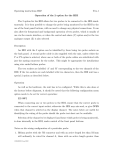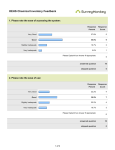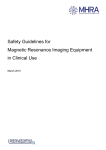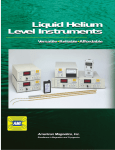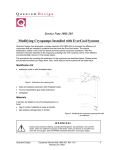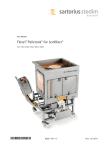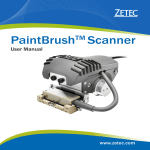Download Magnet Safety Plan - University of New Hampshire
Transcript
Magnet Safety Plan Revised: September 2015 Office of Environmental Health and Safety © 2015 University of New Hampshire. All rights reserved. The most current version of this document can be found at: http://www.unh.edu/research/magnet-safety-0 Revision History Date Revision description Revised by 2 Table of Contents 1.0 Introduction________________________________________________4 2.0 Responsibilities_____________________________________________4 3.0 Superconducting Magnet Hazards_____________________________5 4.0 Registration________________________________________________7 5.0 Site Signage________________________________________________7 6.0 Surveys____________________________________________________7 7.0 SOP and Risk Assessments___________________________________7 8.0 Training____________________________________________________7 9.0 Hazard Warnings and General Precautions______________________8 10.0 Fire Safety________________________________________________8 11.0 Emergency Response_______________________________________9 12.0 Attachment 1: Standard Operating Procedure_________________10 13.0 Attachment 2: Oxygen Deficiency Hazard Risk Evaluation and Response_____________________________________________________13 3 1.0 Introduction Research involving the use of instruments that generate large, static magnetic fields such as Nuclear Magnetic Resonance (NMR) spectrometers or Superconducting Magnet systems is becoming more prevalent at the University of New Hampshire (UNH). In response to the hazards posed by such instruments, UNH has created this Magnet Safety Plan (MSP). This plan should be implemented in conjunction with other written programs and procedures guiding safe laboratory research at UNH facilities. The Office of Environmental Health and Safety (OEHS) should be contacted with any questions or concerns regarding the safe usage of such equipment (603862-4041 or [email protected]). Magnetic fields are measured in units of magnetic induction, such as Gauss (G) or tesla (T) (1 T = 10,000 G.) The magnetic field of the Earth is 0.5 G for instance. Superconducting magnets such as those found in NMR spectrometers have substantially larger magnetic fields which can measure in the tens of thousands or hundreds of thousands of G. Though the magnitude of these fields is significantly reduced over a relatively short distance, potential hazards remain. This plan identifies these potential hazards and the associated control measures to be taken to mitigate their effect. 2.0 Responsibilities Office of Environmental Health and Safety, OEHS: • To register all superconducting magnets. • To conduct annual audits of all superconducting magnets, and to report any items of non-compliance to the Radiation Safety Committee (RSC). • To conduct magnet safety and cryogen training of all Principal Investigators, students, and staff. • To investigate incidents or emergencies. • Perform hazard assessments for equipment. Principal Investigator (PI) or Lab Supervisor: • To take the training offered by OEHS and follow the MSP. • To ensure all staff and students are trained by OEHS prior to entering the lab unsupervised, and to provide site specific training. • To establish and mark the 5 Gauss line. • To write a Standard Operating Procedure and risk assessment. • To wear appropriate personal protective equipment (PPE). • To respond to any incidents or emergencies. • To cooperate with OEHS for annual audits. Magnet Users: • To keep all safety training up to date. • To follow the MSP and the SOP. • To wear the appropriate PPE. • To help ensure safe work practices when their lab supervisor or PI is not present. • To report any incidents or emergencies to their supervisor or PI and OEHS. 4 Radiation Safety Committee: • To respond to any items of non-compliance issued by OEHS. 3.0 Superconducting Magnet Hazards Superconducting magnets present a number of overt and other less obvious hazards. The magnetic field generated by such a magnet may result in minor inconveniences (e.g. erasure of a credit or bank card) to serious medical conditions (e.g. interruption of an implanted medical device, like a pacemaker). These magnets use cryogenic liquids as coolants and can be associated with high-voltage components representing an electrical hazard. Furthermore, items made of glass such as NMR tubes and storage dewars can present a sharps hazard if cracked or broken. Each of these hazards is considered in more detail in the following sections. 3.1 Magnetic Fields Strong magnetic fields are created by instruments employing superconducting magnets. The fields are strongest in close proximity to the magnets and are significantly attenuated in a nonlinear fashion over a relatively short distance. This disparity in field strength can lead to the erroneous assumption that metallic objects can be safely used near such magnets. Though some ferromagnetic materials may not be affected at certain distances from a strong magnetic field, the attraction force increases rapidly as that distance is reduced and can result in such items becoming projectiles aimed at the magnet. Scissors, tools, keys, knives, gas cylinders, chairs (including wheel chairs), carts and other metallic items should not be allowed near the magnet. Magnetic fields are present in three dimensions, so care should be taken when handling objects near magnets. 3.1.1 Magnetic Fields Less Than or Equal to 5 Gauss Magnetic fields ≤ 5G can cause certain effects requiring the protection of personnel and equipment. The operation of sensitive equipment (e.g. electron microscopes) can be affected, so use of such devices in close proximity to superconducting magnets should be carefully considered. These magnetic fields may also result in medical concerns for personnel with medical implants or devices. Anyone with such implants or devices, including but not limited to: pacemakers, metal implants, prosthetics, surgical clips or pins, or neurostimulators, should not enter into these fields. In order to adequately warn personnel of the area restriction associated with such fields, a 5G line should be established for each instrument using superconducting magnets, and this line should be posted with restrictions and warnings as outlined in Section 5.0. The 5G line should be established above, under and around each magnet. 3.1.2 Magnetic Fields Greater than 5G Magnetic fields > 5G can result, in addition to the effects detailed in 3.1.1, the erasure of credit or bank cards, disruption of mechanical devices (e.g. analog watches), disturbance of X-ray tubes and the 5 corruption of magnetic storage devices. Access inside the 5G line should be limited to personnel knowledgeable in the operation of the equipment and adequately trained in the associated hazards. Personnel working inside the 5G line should assess the need to remove jewelry, hair pins, watches, wallets and any other metallic items prior to crossing the 5G line. Follow the Standard Operating Procedure defined by the PI or lab supervisor for specific instructions. 3.2 Cryogenic Liquids Since superconducting magnets use liquid nitrogen and liquid helium as coolants, the precautions associated with handling these cryogenic liquids must also be observed. Cryogens can cause frost bite. Refer to the UNH Chemical Hygiene Plan and OEHS website (http://www.unh.edu/research/environmental-health-and-safety) for additional information. When working with cryogens wear long pants, long sleeves, nonmagnetic closed toe shoes, cryogen gloves, safety glasses, and a face shield. A “quench” can occur should the superconducting magnet be disrupted in a way that causes the loss of superconductivity. In such an event the coil can heat quickly causing the cryogenic liquid to evaporate rapidly. This is characterized by a loud hissing sound caused by the escaping gases. The rapid expansion of these gases into the room can displace the available breathing air resulting in an oxygen deficient environment. In such an event or should an area oxygen level alarm activate, all personnel should leave the room immediately and report the incident to their supervisor and OEHS. 3.3 Electrical Hazards Instruments containing super conducting magnets often require substantial electricity to function. Warning signs and labels on equipment should be heeded, as accidental electrocution can be fatal. Instrument installation, maintenance and repair should only be conducted by the instrument manufacturer, authorized agent or properly trained equipment custodians. Any calibration, maintenance or repair of instrument parts should be completed using non-ferromagnetic tools within the 5 G line as necessary. No person should be allowed to work with or around such instrumentation without proper training. Extreme caution should be used when working within the 5G line. Any leaks or accumulation of water near such equipment should be immediately reported to the equipment custodian or OEHS for assessment and cleaning. Superconducting magnets persist even in power failure or electrical shut off. 6 3.4 Glass Tubes and Storage Dewars Glassware that may be used with superconducting equipment, such as NMR tubes and storage dewars, should be handled with care. These items are made of thin walled glass and if cracked or broken can present a cut or puncture wound hazard. Inspect these items regularly for cracks or sharp edges and remove damaged items from service. Should a glass item break, use remote handling tools to collect the shards of glass and dispose in a rigid walled container such as a sharps container or broken glass box. Be sure that external storage dewars are wrapped in plastic mesh or tape to minimize the spread of glass should one be broken. Principal Investigators or lab supervisors should verify that dewars are nonmagnetic prior to purchasing. 4.0 Registration All superconducting magnets should be registered with OEHS. Please utilize CEMS to register your magnet. 5.0 Site Signage Establish the 5 G line by utilizing the site-planning guide from the manufacturer. Be sure the 5 G line is within the room. Delineate and identify the 5G line, for example with a plastic chain and sign. OEHS will provide door signs to warn of magnetic fields. 6.0 Surveys Surveys will be conducted twice per year by OEHS. Any items of non-compliance will be reported to the Radiation Safety Committee. 7.0 Standard Operating Procedures and Risk Assessments Standard Operating Procedures, SOPs should be written by the PI or lab supervisor. Templates are attached to this document. Please submit to [email protected] when completed for approval. After reading have students sign the SOP. There is an Oxygen Deficiency Hazard Risk Evaluation and Response attached to this document as a template. Please have students read this document. 8.0 Training OEHS offers training in CEMS. There are three trainings which are necessary for students and lab supervisors or PIs. The trainings are Magnet Safety, Cryogen Safety (if appropriate) and Laboratory and Chemical Safety. Contact Michele Arista at [email protected] or Andy Glode at [email protected] to receive the links to these trainings. 7 The University Instrumentation Center (UIC) also offers training. See the standard operating procedure for specific training requirements. Refresher training is offered in magnetic safety and cryogen safety annually. See your lab supervisor or PI for site specific training. 9.0 Hazard Warnings and General Precautions Properly trained personnel should be the only individuals allowed to work with or around equipment containing super conducting magnets. Training should include a review of this Magnet Safety Plan and specific operating procedures for each piece of equipment. Area warnings (e.g. entrances to rooms or labs) should advise all personnel of the presence of magnetic fields, can be associated with electromagnetic radiation, electrical hazards, cryogenic liquids, and other hazards as required by the UNH Hazard Communication Program. Instruments should be installed in areas where adequate clearance exists for coolant filling. The 5G line should be determined during the commissioning of equipment and adequately marked so that unintended entry into a magnetic field of > 5G is prevented. Markings should be in accordance with the UNH Hazard Communication Program and include warnings advising of hazards to individuals with implants, prosthetics or devices that may be adversely affected by the magnetic field. General Safety Precautions include: 10.0 o Unsecured metallic objects should not be brought within the 5G line of a powered magnet. o Remember to check your pockets (wallet, keys, etc.) and clothing (Large belts, large jewelry) for metallic objects before working near a magnet. o Do not lean on or bump the magnet as it may cause a quench. o Compressed gas cylinders should only be allowed in areas where magnets are housed under the permission and supervision of the Personal Investigator or lab supervisor. o Adhere to area access restrictions. The lab should remain locked when the magnet is energized. o There is no eating or drinking in the laboratory. Fire Safety No flammable liquids in excess of five (5) gallons will be brought into the magnet room. A non-magnetic fire extinguisher should be available. Only use a fire extinguisher if you have been trained to use one. 8 Water should not be used on the magnet. In the event of a fire call 9-1-1. Notify your supervisor or Principal Investigator and OEHS of the fire. 11.0 Emergency Response In an emergency involving superconductive equipment, such as instrument quench, immediately evacuate the area and report the event to your supervisor and OEHS. Do not go back in until instructed to do so. If an object becomes stuck to a superconducting magnet, do not attempt to remove it. Contact your supervisor for guidance. Attempting to remove the item may result in injury to personnel or damage to the magnet. Should the magnet be damaged by inadvertent movement, contact with a large object, or other means, thereby increasing the likelihood of quench, evacuate all personnel from the area and contact your supervisor and OEHS. For injury or medical emergency contact 9-1-1. Then contact your lab supervisor and OEHS. Report any injuries with the Report of Occupational Injury or Illness Form at: http://www.unh.edu/hr/sites/unh.edu.hr/files/pdfs/Report_of_Occupational_Injury_o r_Illness.pdf Emergency Contacts: For the Karl Slifer Lab: Karl Slifer: 603-722-0695 Karsten Pohl: 603-436-5207 For the University Instrumentation Center: Pat Wilkinson: 508-320-6542 John Wilderman: 603-833-0054 Office of Environmental Health and Safety: Michele Arista, Radiation Safety Officer: 603-312-2500 Andy Glode, Laboratory Safety Officer: 603-534-9872 Main Office: 603-862-4041 9 Attachment 1 Standard Operating Procedures Title: General Safety Precautions for Work in a Strong Magnetic Field Number TBD Revision 1.0 Date Pages 10 of 1.0 PURPOSE - This procedure provides the minimum safety requirements for working in or near strong magnetic fields associated with research equipment, such as nuclear magnetic resonance spectrometers or Superconducting magnet systems, in operation at UNH. 2.0 SCOPE - This procedure applies to anyone with authority to work in areas restricted by the UNH Magnet Safety Plan for controlled access and includes but is not limited to: research staff, students, visitors, facilities and maintenance personnel and/or service contractors. 3.0 RESPONSIBILITIES - List who is responsible (by job title) for performing work, maintaining records, providing training and ensuring that this procedure is carried out. Refer to the UNH Magnet Safety Plan 4.0 - DEFINITIONS GAUSS: A unit of magnetic induction, equal to one ten thousandth of a Tesla TESLA: The SI unit of magnetic flux density STRONG MAGNETIC FIELD: Any magnetic field greater than 5 Gauss. PRINCIPAL INVESTIGATOR: Individual responsible for implementation of standard operating procedure and assuring operations are conducted in accordance with applicable health and safety requirements 5.0 HEALTH AND SAFETY WARNINGS - List all Personal Protective Equipment needed for procedure. - List hazards of chemicals, biological, equipment, etc., used in procedure. - List any special emergency equipment needed (eyewash, spill kit) - List any special waste disposal requirements (biological waste, chemical waste) Refer to the controls listed in related risk assessments and the UNH Magnet Safety Plan. In general these restrictions should be followed when working in or around strong magnetic fields: - Do not bring unsecured metallic objects within the 5G line - Do not lean on or bump into magnets - Compressed gas cylinders are generally not allowed in areas with strong magnetic fields - Access to area should be restricted to approved personnel only and all entries should be posted with access restrictions - No food or drink is allowed 10 - Flammable liquids are limited to ≤ 5 gallons in the room Non-metallic fire extinguisher should be used 6.0 MATERIALS - List materials and equipment needed for procedure. Be specific. Include chemical concentrations, catalog numbers, equipment names, model numbers, etc. Include any material or equipment set up procedures that need to be done before procedure can proceed (e.g. warm up water, dilute bleach). Cross reference any other SOPs for these procedures. Describe how to obtain equipment. 7.0 PROCEDURES - List a step-by-step description of the procedure in chronological manner using active verbs and direct statements. Describe any anticipated problems that may occur while performing this SOP, the course of action to be taken, including the job title to consult/report to if problem occurs. 8.0 REPORTING AND DOCUMENTATION - Describe any logs, reports or other documentation needed or produced during this SOP. Describe where records are kept. 9.0 REFERENCES - List equipment manufacturer user manual, regulations or references relating to this SOP. Refer to the UNH Magnet Safety Plan and Oxygen Deficiency Risk Evaluation and Response procedure 10.0 ATTACHMENTS, FORMS, CHECKLISTS - Attach documents listed above as necessary. See attached area magnet safety survey 11.0 REVIEWS AND REVISIONS - List review cycle (e.g. annually) and procedure (e.g. supervisor, committee). Include author & approval signatures. Please post this SOP in close proximity to the magnet in clear view of the operator. Operator Review: I have read and understand this operator procedure, and I agree to follow the procedure each time I use the superconducting magnet. Name: Print Signature Date 11 This SOP should be reviewed and revised at least annually by the PI or lab supervisor. OEHS approval is required. Signature Job Title Date This SOP was written by: This SOP was reviewed y: This SOP was approved y: Rev. 9/15 12 Attachment 2 UNH Oxygen Deficiency Hazard (ODH) Risk Assessment Standard Operating Procedure Office of Environmental Health and Safety 1.0 INTRODUCTION The University of New Hampshire (UNH) conducts operations using various hazardous materials that may reduce available breathing air in occupied spaces thereby creating an oxygen deficiency hazard (ODH). The Office of Environmental Health and Safety (OEHS) has established this Risk Evaluation and Response procedure to identify potential ODH operations on campus. UNH is committed to maintaining all personnel exposures to oxygen deficient atmospheres to As Low As Reasonably Achievable (ALARA) levels. The Risk Evaluation and Response process involves a detailed risk assessment of the operations and associated hazards culminating in written conclusions identifying required control measures. This process and applicable control measures are detailed herein. 2.0 ODH RISK ASSESSMENT An OEHS ODH Risk Assessment should include a written consideration of the following topics: 1) Describe the area being assessed including building, room identifier and proposed operations in the area; 2) Identify sources that are stored or used in the area that may result in a reduced oxygen atmosphere; 3) Detail possible failures of containment systems, including equipment failures, operator errors, and accidents; 4) Describe operational steps and include controls required for each step to minimize the risk of failure, error, or accident. Include steady state (normal operation), start up, standard repairs and maintenance, special operations, or high hazard activities and shutdown; 5) Document the properties and volumes of the gases that could be released in a planned or unplanned event and how these properties could result in an ODH in the area. Include a discussion of the available ventilation (natural and forced) and the expected mixing and diffusion of gases; 13 6) Document what control measures are required, if any, for the area (see Section 3.0). 3.0 ODH CONTROL MEASURES Protective measures must be implemented whenever an oxygen deficiency hazard exists so that exposure of personnel to such environments is maintained As Low As Reasonably Achievable (ALARA). The following controls should be implemented as a result of the risk assessment and before the start of operations. 1) Environmental Controls Verify that the ventilation system to the impacted areas is operating as identified in the Risk Assessment. If the ventilation system is not expected to prevent oxygen deficient atmospheres in all conditions, then area oxygen level monitoring is required. Identify the number, type, and location of oxygen monitors to be installed in the area(s). Oxygen monitors should be set to alarm at 19.5%, or as required in the risk assessment. 2) Access Controls Entrance postings should be placed at entrances to all areas where potential oxygen deficiency hazards exist. These postings are correlated to the degree of danger presented by the operations, volumes, and type of hazards present. Control levels are as follows: Level 1: Applicable for area(s) in which all sources of ventilation are not expected to prevent possible reduced oxygen levels, but controls are in place which would allow ample time for evacuation in the event of an incident. Requirements: a) Entry Posting - The ODH Level 1 posting is a special warning to personnel entering and occupying these spaces and notification that oxygen monitors are in use and evacuation is required upon alarm activation. Rooms that are identified as an ODH Level 1 will be indicated on lab door Caution signs. b) ODH Awareness Training for personnel working in the area, including procedures for emergency evacuation. 14 Level 2: Applicable for area(s) in which adequate controls to prevent oxygen deficiency from occurring rapidly, thereby limiting or reducing the likelihood of timely evacuation, are not present. Requirements: a) Entry Posting - The ODH Level 2 posting is meant as an elevated warning to personnel that occupancy is prohibited without OEHS approval and an emergency escape breathing apparatus. Rooms that are identified as an ODH Level 2 will be indicated on lab door Caution signs. b) ODH Awareness Training for personnel working in the area c) Evacuation and Emergency Response Training d) Medical Evaluation and Surveillance e) Respiratory Protection and Use Training f) 3) Buddy system for constant communication Emergency Procedures Written emergency procedures should be included in operating procedures and should include incident recognition, immediate steps to take in the event of an oxygen deficiency hazard event, alarm recognition, and reporting requirements. Rev. 9/15 15















